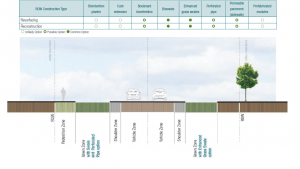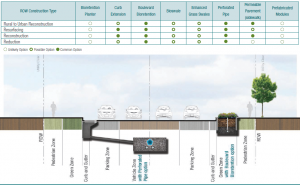Difference between revisions of "LID opportunities in road-right-of-ways"
| Line 52: | Line 52: | ||
*Institutions such as schools, recreational facilities, and churches are often located along collectors | *Institutions such as schools, recreational facilities, and churches are often located along collectors | ||
| − | ''' | + | ===Typical LID opportunities=== |
| + | '''Within the roadway:''' | ||
*Permeable pavement should be avoided for high traffic travel lanes, but they are an option for parking lanes | *Permeable pavement should be avoided for high traffic travel lanes, but they are an option for parking lanes | ||
and sidewalk. However, permeable pavers are susceptible to clogging if receiving runoff drainage from adjoining asphalt roadway. Pervious concrete or porous asphalt are options for bike lanes. | and sidewalk. However, permeable pavers are susceptible to clogging if receiving runoff drainage from adjoining asphalt roadway. Pervious concrete or porous asphalt are options for bike lanes. | ||
Revision as of 13:19, 26 September 2017
ROW standards in Ontario vary by municipality, but generally there are seven typical ROW types:
- Local residential road
- Residential collector road
- Local industrial road
- Industrial collector road
- Minor arterial
- Major arterial road
- High density commercial road
The characteristics, LID opportunities and constraints, and examples are presented for each of these ROW types on the following pages. Typical LID options for each of these street types are offered. However, this guidance is not intended to be prohibitive of other LID options, but rather to help reduce the number of LID options in the preliminary phases of screening and alert the designer to LID opportunities unique to that road type. Other considerations such as adjacent landuses, traffic demands, utility locations, budget constrains and geological conditions will determine the most appropriate LID solution.
Local residential road[edit]
Rural Cross-Section[edit]
Local residential streets are the most common street type. They serve as access to the residential lots within those areas created by, or bounded by, thoroughfares, arterials, collectors,and primary residential streets and other physical boundaries such as natural streams and railroads. Since the primary function is local vehicular access rather than intercommunity circulation, theses roads have low traffic volumes and mostly lightweight vehicular traffic, but they must accommodate the rapid access needs of emergency vehicles. Other characteristics specific to the residential rural cross section include:
- Shoulders are grassed, gravel, or bare soil from winter maintenance, pedestrians and street side parking
- Side drainage ditches are often narrow, poorly graded,and can be difficult for homeowners to maintain
- Utilities are often in separate trenches rather than a combined utility trench
Typical opportunities for rural cross section within the roadway:
- Use of permeable pavement within the roadway is not economical when there are adjacent swales to filter and infiltrate runoff
Within the boulevard:
- Bioswales or the use of perforated pipes beneath grass swales can reduce the nuisance problems associated with conventional swales like standing surface water and steep slopes
- Permeable pavement systems can be used to stabilize and improve degraded shoulders
- Converting degraded ditches to enhanced grass swales is the simplest LID improvement to make to residential rural cross-section roads. Driveway culverts can be slightly raised to provide storage and encourage infiltration
Urban Cross-Section[edit]
Characteristics specific to the urban cross section include:
- Parking zones are often underused
- Residential boulevard space is the easiest to modify and use for stormwater management compared to other street types
- Utility lines may be in separate or shared trenches
Typical LID opportunities Within the roadway:
- Curb extension bioretention is a good method for
calming traffic and using underutilized parking zones
- Due to low speeds and low traffic, permeable pavement can be used for the roadway from curb to curb
Within the boulevard:
- Boulevard bioretention can be easily incorporated into a rural to urban upgrade by allowing for stormwatertreatment within the boulevard space
Residential collector road[edit]
The function of these streets is to act as connectors between residential neighborhoods and other collectors and arterials. The character of these streets can vary widely from completely residential to pockets of commercial or mixed use land uses. Other characteristics include:
- Moderate to high traffic volumes, average daily traffic 1500 to 3000 vehicles
- Street parking is atypical unless there are adjacent mixed uses.
- Often have multi-modal use, transit, pedestrian, and cyclists
- Institutions such as schools, recreational facilities, and churches are often located along collectors
Typical LID opportunities[edit]
Within the roadway:
- Permeable pavement should be avoided for high traffic travel lanes, but they are an option for parking lanes
and sidewalk. However, permeable pavers are susceptible to clogging if receiving runoff drainage from adjoining asphalt roadway. Pervious concrete or porous asphalt are options for bike lanes.
- Perforated pipes are suitable for collectors with very limited space and particularly where there is no routine landscaping maintenance. However, adequate pretreatment such as grass swales, extended sump catchbasins, or prefabricated units must be provided.
- Curb extension bioretention is not a common practice for collectors, but they can be used in some cases to reduce pedestrian crossing distances at intersections
Within the boulevard:
- Collectors with few driveway access points and continuous stretches of open boulevard space are good candidates for bioswales
- Institutional uses along collectors offer opportunities for innovative LID solutions. Runoff can be treated within adjacent park space or on school properties where agreements have been made with school boards. These areas are also good opportunities for LID showcases or demonstrations.
Local Industrial road[edit]
The function of local industrial roads is to provide access to industry and other employment zones. The ability to provide access and easy movement for large vehicles are a primary design characteristic of these types of streets. They are two to three lanes and are not intended for through traffic. Other characteristics include:
- Traffic volumes may be low but the road must still be wide enough to accommodate large vehicle turning movements and have increased structural strength to support heavy loads
- To avoid interference with truck movements landscaping should be low, and trees should be high branching or setback from the roadway
- Boulevards are often wide allowing for swale or other landscape treatment options
Typical LID opportunities[edit]
Within the roadway:
- Consideration should be given for wide turning trucks which may encroach on and degrade landscaping or road shoulders. Grid paver systems or widened gravel shoulders near turning areas can be used to accommodate occasional encroachment.
Within the boulevard:
- LID options for local industrial roads will heavily depend on the adjacent industries. For example, bioswales and other filtering practices may clog quickly where heavy industry like concrete mixing plants will track sediment onto the roads. Grass swales with sediment traps or prefabricated oil/grit separators which can be cleaned out on a frequent routine basis would be appropriate. Conversely, bioswales and perforated pipe can work well in areas of light industrial and commercial landuses.
Industrial collector road[edit]
Minor arterial[edit]
Major arterial road[edit]
High density commercial road[edit]
Go back to Screening LID Options

